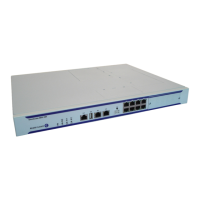Interface Configuration
7750 SR OS Interface Configuration Guide Page 277
.All but a few exception SONET/SDH parameters for the working channel port must be
configured in the config>port>aps>sonet-sdh context. The protection channel inherits all the
configured parameters. The exception parameters for the protection channel can be configured in
the config>port>aps>sonet-sdh context.
Signal failure (SF) and signal degrade (SD) alarms are not enabled by default on POS interfaces.
It is recommended to change the default alarm notification configuration for POS ports that
belong to APS groups in order to be notified of SF/SD occurrences to be able to interpret the
cause for an APS group to switch the active line.
For path alarms, modify the logical line aps-id in the configure>port aps-id<sonet-sdh>path
report-alarm context. For example:
configure port aps-1 sonet-sdh path report-alarm p-ais
For line alarms, separately, modify the 2 physical ports that are members of the logical aps-id
port (the working and protect lines). APS reacts only to line alarms, not path alarms.
For example:
configure port 1/2/3 sonet-sdh report-alarm lb2er-sd
configure port 4/5/6 sonet-sdh report-alarm lb2er-sd
For example:
A:ALA-48>config>port>aps# info
----------------------------------------------
working-circuit 1/2/3
protect-circuit 4/5/6
----------------------------------------------
A:ALA-48>config>port>aps#
If the SD and SF threshold rates must be modified, the changes must be performed at the line
level on both the working and protect APS port member.
The no form of this command deletes an aps-group-id or bundle-aps-group-id. In order for an
aps-group-id to be deleted,
The same rules apply for physical ports, bundles deletions apply to APS ports/bundles deletions
(for example an aps-group-id must be shutdown, have no service configuration on it, and no path
configuration on it). In addition working and protection circuits must be removed before an aps-
group-id may be removed.
Syntax: port aps-group-id
aps:keyword
group-id: 1 — 64
Example: port aps-64
bpgrp-id — Creates a bundle protection group (BPG). The BPGrp consists of a working and
protection bundles that provide APS protection to each other using bi-directional APS as
supported on the 7750 SR-Series family of products. All members of a working/protection
bundle must be on the same working/protection circuit respectively of the same, already
provisioned APS group.
The working bundle must have already been created in the config>port context before services
can be created on a BPGrp.

